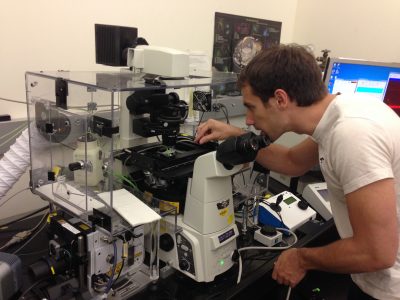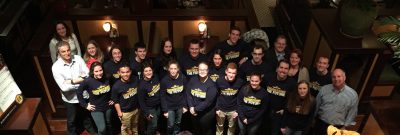
As he nears the completion of his PhD in chemical engineering, Erik Carboni has had plenty of time to acquaint himself with the useful facilities and knowledgeable staff here at the University of Connecticut. Over the years Erik has learned that if he needs a certain machine or instrument, he can easily find and use it. “If I had to describe UConn in one word, I would say that it is productive.”
The Connecticut native chose UConn knowing it was a strong school for chemical engineering. UConn’s top ranked school of pharmacy was a plus for Erik, since it enabled him to add a pharmaceutical component to his research.
Erik is investigating the flow behavior of nano and micro-particles in blood. The goal of his research is to improve drug delivery to cancerous tumors and other diseases. He finds it rewarding to contribute to treatment therapies. “If we can find the optimal size and shape that leads to maximal margination—which is the movement of particles toward the blood vessel wall—then we can maximize the delivery of nanoparticle drug carriers.”
Last October, Erik presented his work at the Society of Rheology annual meeting in Philadelphia. The talk was titled, “The Rheology of Nanoparticles in Blood for Improved Cancer Therapy.” This research offers a new perspective on mechanisms associated with margination.
Erik treasures the mentorship provided by his Ph.D. advisor, Dr. Anson Ma. “He found a project for me that he knew that I would enjoy working on. He is someone who genuinely cares about his students.”
After receiving his PhD, Erik aspires to a research position at a pharmaceutical company, but would love to teach if the opportunity presented itself.

 The Board of Directors of the American Institute of Chemical Engineers has elected
The Board of Directors of the American Institute of Chemical Engineers has elected  he United States remains the top graduate destination in the world. With superior quality and flexibility in its programs, UConn has everything the best programs have to offer and more. Third year PhD student Jie Qi stands by her decision to study Chemical Engineering here. “I chose UConn because of its strong reputation as a research University,” she says, “There are many great opportunities available to students including different internships, various options for financial aid, and a great network of alumni.”
he United States remains the top graduate destination in the world. With superior quality and flexibility in its programs, UConn has everything the best programs have to offer and more. Third year PhD student Jie Qi stands by her decision to study Chemical Engineering here. “I chose UConn because of its strong reputation as a research University,” she says, “There are many great opportunities available to students including different internships, various options for financial aid, and a great network of alumni.”

 Graduate students have many reasons to choose UConn, from conducting research in world class facilities, to a welcoming learning environment, and no shortage of school pride (not everyone wins dual National Championships in basketball).
Graduate students have many reasons to choose UConn, from conducting research in world class facilities, to a welcoming learning environment, and no shortage of school pride (not everyone wins dual National Championships in basketball). David’s faculty advisor is
David’s faculty advisor is  Dr. Yongku Cho, Assistant Professor in the Department of Chemical and Biomolecular Engineering, has received a prestigious and highly competitive
Dr. Yongku Cho, Assistant Professor in the Department of Chemical and Biomolecular Engineering, has received a prestigious and highly competitive  critical backing to enable him to collect pilot data for his innovative ideas. His grant will support Dr. Cho’s research group to develop a novel approach for rapid and reversible knockout of target genes. His group will research which regulated protein levels affect brain circuits. They will specifically study the mechanism of GABAA receptor dysfunction. Deficits in GABAA receptor function have been linked to multiple neurological and psychiatric disorders, such as epilepsy and schizophrenia. With his new technique, he intends to study the role of GABAA receptor interacting proteins, which may lead to therapeutic targets for such diseases.
critical backing to enable him to collect pilot data for his innovative ideas. His grant will support Dr. Cho’s research group to develop a novel approach for rapid and reversible knockout of target genes. His group will research which regulated protein levels affect brain circuits. They will specifically study the mechanism of GABAA receptor dysfunction. Deficits in GABAA receptor function have been linked to multiple neurological and psychiatric disorders, such as epilepsy and schizophrenia. With his new technique, he intends to study the role of GABAA receptor interacting proteins, which may lead to therapeutic targets for such diseases. research at Wisconsin, Dr. Cho is now interested in manipulating these proteins to include new functions. “The broader objective of the work is to engineer antibodies with useful functionalities that they normally would not have,” says Dr. Cho.
research at Wisconsin, Dr. Cho is now interested in manipulating these proteins to include new functions. “The broader objective of the work is to engineer antibodies with useful functionalities that they normally would not have,” says Dr. Cho. For the third consecutive summer, UConn’s Chemical & Biomolecular Engineering (CBE) Department hosed an NSF sponsored
For the third consecutive summer, UConn’s Chemical & Biomolecular Engineering (CBE) Department hosed an NSF sponsored  Instruments), High-Performance Nanostructured Organic/Inorganic Hybrids for Functional Applications (Nanocor), Development of Scalable Droplet Microfluidic Devices (BASF), Increasing Soil Water Retention with Bacteria (DuPont), Characterization of TiO2 Thin Films on 316L Stainless Steel Formed using a Sol-Gel Technique (VeruTEK Technologies), Plasmonic Nanodevices for Solar Energy Harvesting (Scitech Solar), and Sustainable Biofuels Production (RPM Sustainable Technologies).
Instruments), High-Performance Nanostructured Organic/Inorganic Hybrids for Functional Applications (Nanocor), Development of Scalable Droplet Microfluidic Devices (BASF), Increasing Soil Water Retention with Bacteria (DuPont), Characterization of TiO2 Thin Films on 316L Stainless Steel Formed using a Sol-Gel Technique (VeruTEK Technologies), Plasmonic Nanodevices for Solar Energy Harvesting (Scitech Solar), and Sustainable Biofuels Production (RPM Sustainable Technologies). Students spent their summer in a world-class academic research laboratory with state-of-the art instrumentation. They also toured local incubator spaces, and participated in an Innovation Accelerator event at a local private incubator.
Students spent their summer in a world-class academic research laboratory with state-of-the art instrumentation. They also toured local incubator spaces, and participated in an Innovation Accelerator event at a local private incubator. Dr. Yu Lei, Associate Professor of Chemical and Biomolecular Engineering at the University of Connecticut, received a US Patent for his explosive detection technology.
Dr. Yu Lei, Associate Professor of Chemical and Biomolecular Engineering at the University of Connecticut, received a US Patent for his explosive detection technology.